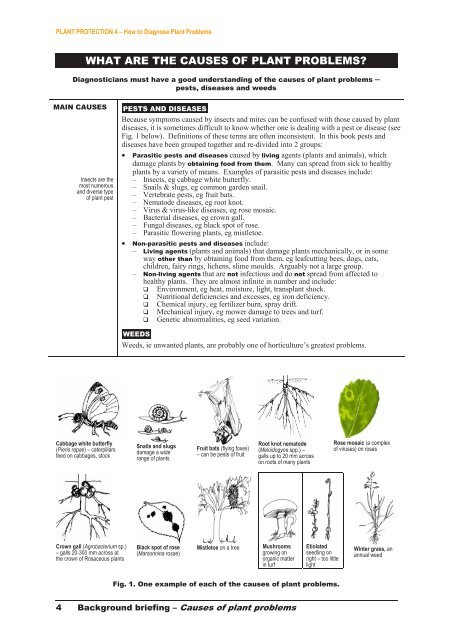PLANT PROTECTION 4
PLANT PROTECTION 4
PLANT PROTECTION 4
You also want an ePaper? Increase the reach of your titles
YUMPU automatically turns print PDFs into web optimized ePapers that Google loves.
<strong>PLANT</strong> <strong>PROTECTION</strong> 4 – How to Diagnose Plant Problems<br />
WHAT ARE THE CAUSES OF <strong>PLANT</strong> PROBLEMS?<br />
Diagnosticians must have a good understanding of the causes of plant problems <br />
pests, diseases and weeds<br />
MAIN CAUSES<br />
Insects are the<br />
most numerous<br />
and diverse type<br />
of plant pest<br />
Cabbage white butterfly<br />
(Pieris rapae) – caterpillars<br />
feed on cabbages, stock<br />
Crown gall (Agrobacterium sp.)<br />
– galls 20-300 mm across at<br />
the crown of Rosaceous plants<br />
PESTS AND DISEASES.<br />
Because symptoms caused by insects and mites can be confused with those caused by plant<br />
diseases, it is sometimes difficult to know whether one is dealing with a pest or disease (see<br />
Fig. 1 below). Definitions of these terms are often inconsistent. In this book pests and<br />
diseases have been grouped together and re-divided into 2 groups:<br />
Parasitic pests and diseases caused by living agents (plants and animals), which<br />
damage plants by obtaining food from them. Many can spread from sick to healthy<br />
plants by a variety of means. Examples of parasitic pests and diseases include:<br />
– Insects, eg cabbage white butterfly.<br />
– Snails & slugs, eg common garden snail.<br />
– Vertebrate pests, eg fruit bats.<br />
– Nematode diseases, eg root knot.<br />
– Virus & virus-like diseases, eg rose mosaic.<br />
– Bacterial diseases, eg crown gall.<br />
– Fungal diseases, eg black spot of rose.<br />
– Parasitic flowering plants, eg mistletoe.<br />
Non-parasitic pests and diseases include:<br />
– Living agents (plants and animals) that damage plants mechanically, or in some<br />
way other than by obtaining food from them, eg leafcutting bees, dogs, cats,<br />
children, fairy rings, lichens, slime moulds. Arguably not a large group.<br />
– Non-living agents that are not infectious and do not spread from affected to<br />
healthy plants. They are almost infinite in number and include:<br />
Environment, eg heat, moisture, light, transplant shock.<br />
Nutritional deficiencies and excesses, eg iron deficiency.<br />
Chemical injury, eg fertilizer burn, spray drift.<br />
Mechanical injury, eg mower damage to trees and turf.<br />
Genetic abnormalities, eg seed variation.<br />
WEEDS.<br />
Weeds, ie unwanted plants, are probably one of horticulture’s greatest problems.<br />
Snails and slugs<br />
damage a wide<br />
range of plants<br />
Black spot of rose<br />
(Marsonnina rosae)<br />
Fruit bats (flying foxes)<br />
– can be pests of fruit<br />
Mistletoe on a tree<br />
Root knot nematode<br />
(Meloidogyne spp.) –<br />
galls up to 20 mm across<br />
on roots of many plants<br />
Mushrooms<br />
growing on<br />
organic matter<br />
in turf<br />
4 Background briefing – Causes of plant problems<br />
Etiolated<br />
seedling on<br />
right – too little<br />
light<br />
Fig. 1. One example of each of the causes of plant problems.<br />
Rose mosaic (a complex<br />
of viruses) on roses<br />
Winter grass, an<br />
annual weed






![[Compatibility Mode].pdf](https://img.yumpu.com/27318716/1/190x135/compatibility-modepdf.jpg?quality=85)










